THE JADED DOOR-NAIL MEAT PIES RUBBED W/ SCALLION BUTTER
DOESN’T IT HELP YOUR CONFIDENCE IN MAKING THESE IN YOUR OWN KITCHEN, KNOWING THAT THEY AREN’T IMMORTALS,
THAT THEY TOO BLEED JUICE, JUST LIKE THE REST OF US.
To most people who aren’t born or raised in China or any of its politically disputed subparts, the idea of cooking Chinese cuisine, I guess, can feel intimidating. For one, it sounds big. And it is big. It is big in a sense that it’s actually less confusing to approach it not as a generalized whole, but as a ccoalition of many different regional representatives. The food cultures in the north, really is a world away from the south, and from the east coast-lines to the west high mountains, vice versa. And to make matters more complicated than say, how it is in America, in the best as well as the worst sense, the gaps between regional cultures aren’t yet as erased by modernization and technologies as we speak. So if you think you’re scared about making southern dim-sum simply because you aren’t Chinese, know that there’s someone else born and raised in northern China, who feels just the same. But I’m not saying this to scare you. I’m saying this to let you know that, yes, while there is real deep stuff to be sorted out in the study of Chinese cuisine, it is also just as important to know that a lot of it, is actually just bullshit.
Now, this is the first mental fortification you should master if you want to tackle this massive beast, knowing its bluff, knowing that a lot of the seemly variations in its dishes are just the smokes of admirable marketing campaigns. For one example, when it comes to the dazzling and curious case of unleavened meat pies (where the dough is without yeast), besides their shapes and sizes and minor variations in flavours, I’m afraid that the only clear difference, like many other dishes I might add, lies within the fabrication of their biographies.
Chinese likes to dream up mystical background stories for their culinary legends, much like the way how people love to believe that Apple began humbly from a pile of junks inside Steve Job’s garage. And speaking of whom, now I think about it, these stories almost always circulate around some kind of emperors (or empresses) just as well. Take these two for example, the most common types of meat pies that can be seen all over the streets in Beijing, the large and flat xiang-he (fragrant river) meat pies, and the small and stubby men-ding (door nail) meat pies. Both are made up with a thin layer of soft and unleavened dough that’s stuffed with ground beef filling (or pork if you’d like) seasoned with dark soy sauce, toasted sesame oil, blah blah and all the usual suspects. But what really makes them stand apart from each other, flavourfully speaking if any, is of course, the legends.
The legend has it, that one day in the year of 1770 (specification is the key to a believable bullshit), the Qian Long emperor of the Qing dynasty, disguised as a commoner (so he didn’t startle the peasant girls, obviously), travelled to the region of the fragrant river xiang-he and walked into a local joint famous for its meat pies (because the emperor ate what the people ate). He, or one of his disguised entourages ordered the meat pie, and upon the second bite (after the poison-tester took the first), the emperor was stunned by the unparalleled deliciousness coming through this humble commoner’s food (I suspect because he only had shits to eat in his grand palace). He immediately demanded for his awesomely cool calligraphy tools and left a little poem right then and there (the emperor liked to immediately write down whatever that occurred to him because he cared too much), “Xiang-he has this magic pie, the cook owns his wonderful skills. A meal at this very joint, non of the others can fulfil. (the emperor didn’t have to be good at poems. he was the emperor.)”. And just like, boom, the xiang-he meat pie was born, and exploded in popularity across the country.
But the men-ding (door nail) meat pie is not gonna go down without a fight. The legend has it, that one day the imperial chef of The Forbidden City made a peculiarly shaped meat pie that was 6 cm wide and stood 4 cm tall (nobody in China had ever imagined such ingenuity), and served it to the Empress dowager of the late Qing dynasty, Ci Xi (probably the most resented, hated, blackened, evil political bitch of the entire Chinese history). Upon her first bite (as always), Ci Xi was impressed by the dish (and believe me, she didn’t get impressed easily) and asked the imperial chef for the name of the meat pie. The chef took a few seconds (probably peeing his pants at the moment from the fear of being beheaded if he didn’t have an answer), and thought the shape of the giant metal door-nails on the wooden gates of the palace, really resembled his creation, so he answered, “It’s men-ding (door nail) meat pie”. And just like that, the men-ding meat pie was born, and for no reason in particular, forever symbolizes peace and prosperity (doesn’t everything).
I mean let’s face it, non of that ever happened, probably just endorsements the restaurants made up to sell the customers meat pies, either flat and wide or stubby and tall, that practically makes and tastes the same. So you see, a seemingly confusing and intimidating variation of Chinese meat pies, demystified. I for one, prefer the door-nail meat pies. It’s got a nice ring to it. But doesn’t it help your confidence in making both of them in your own kitchen, knowing that they aren’t immortals, and that they too bleed, just like the rest of us. In fact, they do bleed, squirt actually, if not careful, of scorching meat-juice that runs through their pressed skins that are crispy on the top and bottom, but soft and delicate on the sides. The ground beef filling teeming with diced scallions, are bouncy and almost succulently juicy, outweighing the wrapper in mystical proportions. But why stop there? Why not make a new legend? A good nub of pureed scallion and ginger butter is then smeared and melted all over the top, announcing a new chapter in its ever evolving story. The legend has it, that when I rubbed the scallion butter over the hot crackly pie-surfaces and watched it encase slowly, and ever so mesmerisingly, down and around the edges of my creations, I saw the fiercely green jade bangle around my left wrist and was bewitched by the resembling beauty… Right then and there, I took my sharpie and wrote down on a napkin tinted with watermelon juice…
Just like that, the jaded (pun intended) door-nail meat pies rubbed in scallion butter, was born, and forever symbolizes truth and the needlessness for bullshits when it comes to making good foods.
Ingredients
- 2 cups + 1 tbsp (300 grams) bread/high-gluten flour (12~14% protein)
- 1 cup (240 grams) warm water at 125F/55C, plus 1 tbsp (15 grams)
- 3/4 tsp salt
- 21 oz (600 grams) ground beef or pork
- 1 cup (85 grams) finely diced scallions
- 3 1/2 tbsp soy sauce
- 2 tbsp toasted sesame oil
- 1 tsp ground white pepper
- 3/4 tsp light brown sugar
- 5 tbsp cold water?or beef stock if available)
- 4 tbsp (56 grams) unsalted
- 1/2 tbsp diced ginger
- 1/2 cup (43 grams) diced scallions
- Ground white pepper and chili flakes to dust
- Xi'an style chili oil to serve
Instructions
- TO MAKE THE DOUGH: In a stand-mixer with dough-hook, or hand-held mixer with dough-hook, knead bread flour, 1 cup (240 grams) of warm water (a bit too hot to leave your finger inside comfortably) and salt on low speed for 3 minutes, scraping down the bottom and sides a couple times, until evenly incorporated. The dough will feel slightly dry at first, then as it kneads, become very wet and sticky. Switch to high speed and knead for another 6~8 minutes until smooth and very elastic. Now add 1 extra tbsp of water and continue to knead on high for another 5 min, until the dough is shiny and lava-like (adding water in 2 stages increases the water-absorbency of the flour). Cover the bowl with plastic-wrap and let rest for at least 2 hours, up to several hours (you can make the dough in the morning and use it for dinner at night). At which point, the dough should look extremely shiny and flattened out without form.
- TO MAKE THE FILLING: In a bowl, mix ground beef (or pork), diced scallions, soy sauce, toasted sesame oil, ground white pepper and light brown sugar with a fork. Keep stirring until you feel the mixture getting thick and resistant. Then start evenly mixing in the water (or beef stock), 1 tbsp at a time, until it's fully absorbed into the mixture, about 30 seconds for each addition. Cover with plastic-wrap and set aside in the fridge.
- TO MAKE THE SCALLION BUTTER: In a food-processor, pulse unsalted butter with diced ginger until evenly pureed (scraping the sides a few times). Add the diced scallions and pulse again until finely minced into the butter. Set aside.
- TO MAKE/COOK THE SMALL DOOR NAIL MEAT PIES: This dough is EXTREMELY WET, so don't be afraid to dust it with more flour as you go. With oiled hands, take about 2 tbsp of the dough and set it on a well-dusted surface. Dust the top with more flour then flatten it into a thin disk with your hands, but making the edges gradually thinner than the center (let's say 4 mm in the center and 2 mm for the edges). Place about 3 tbsp of filling (be real generous with the filling) in the center, then pull the sides of the dough up and pinch it tightly to seal on the top (if you feel that there's too much excess dough on the top, you can pinch it off). Because the dough is wet and stretchy, this should be quite easy to do. Turn the pie over now to make sure it's not sticking, then with you palms, gently pat and squeeze all around the pie to evenly distribute the filling, then set aside on a well floured plate. Repeat with the rest.
- At this point, the pies are too soft to be shaped into the tall "door nail / biscuit" shape, so flash freeze the pies for about 1 hour until slightly hardened, then shape them into round cylinders about 1 1/2" (4 cm) tall with flat tops and bottoms. Coat the bottom of a flat non-stick skillet with 2 tbsp canola oil and heat over medium-high heat, then arrange the peat pies with about 1" (3 cm) space in between. Once they start to sizzle, add 3 tbsp of water and put the lid on immediately (the pies are thick so they need steam to help cooked through). Turn the heat DOWN TO MEDIUM and cook for about 5~7 min until the steam has fully evaporated, and the bottom of the pies are golden browned. Carefully flip the pies and cover with lid only halfway (but don't add more water). Cook for another 5 min until the second side is golden browned as well. Transfer to a serving plate, and while still hot, rub the top with scallion butter and dust with white pepper and chili flakes. Serve immediately with chili oil.
- TO MAKE THE LARGE XIANG-HE MEAT PIE: This dough is EXTREMELY WET, so don't be afraid to dust it with more flour as you go. With oiled hands, take 1/2 of the dough and place on a well-dusted surface. Dust the top again with flour, and flatten it into a large disk, making the edges gradually thinner than the center (let's say 10 mm in the center and 5 mm on the edges). Place 1/2 of the filling in the center, then pull the sides of the dough up and pinch tightly to seal on the top, and pinch off any excess. Turn the pie over now to make sure it's not sticking. Now your hands or rolling pin, gently flatten the pie outwards from the center towards the edges until it's about 1/3" (10 mm) thick.
- Coat the bottom of a flat non-stick skillet with 2 tbsp of canola oil and heat over medium-high heat. Gently curl the pie onto a rolling pin and carry over the skillet, then unroll to release it onto the skillet. Cook for about 5 min until golden browned on the first side, then flip with a wide spatula, and cook for another 5 min until browned on the second side as well. Transfer to a serving plate, and while still hot, rub with scallion butter and dust with white pepper and chili flakes. Serve immediately with chili oil.
Notes
I ran out of dark soy sauce while making this recipe, but if you do have it, use 2 tbsp dark soy sauce and 1 1/2 tbsp regular soy sauce. It will give the filling a better color.
The door-nail meat pie, compared to xiang-he meat pie, has a higher meat ratio and more juice, which I prefer.


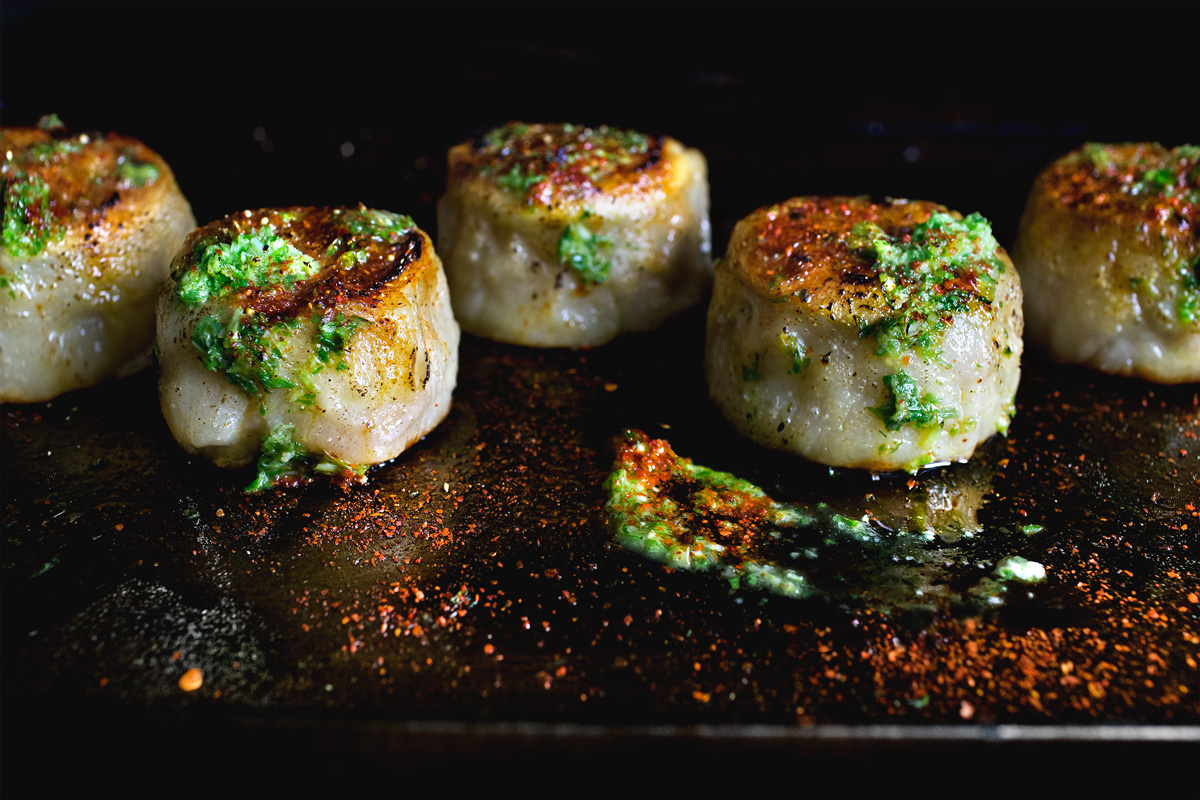
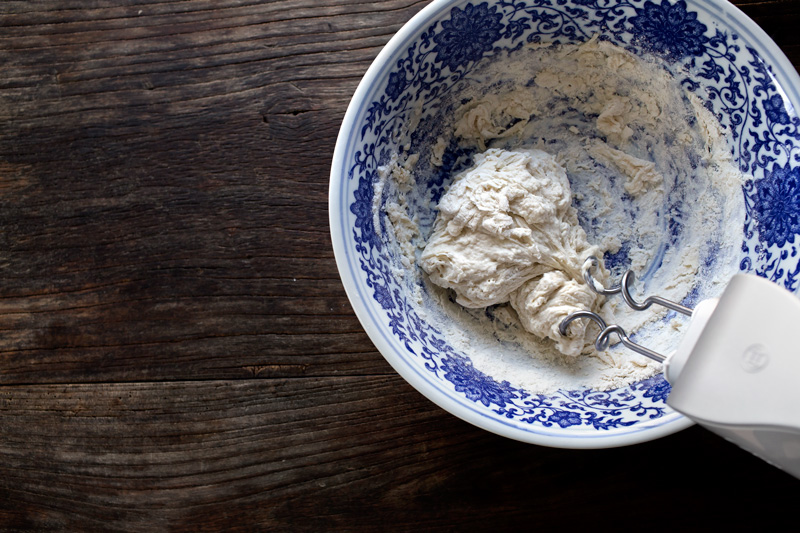
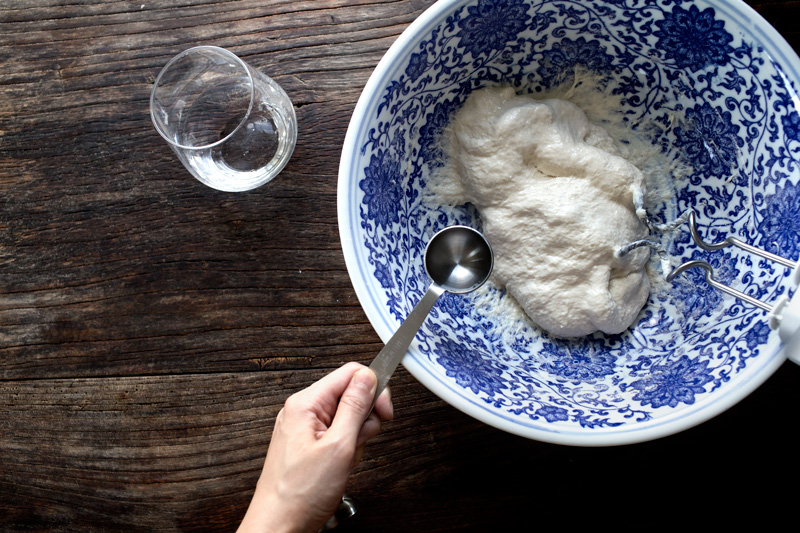
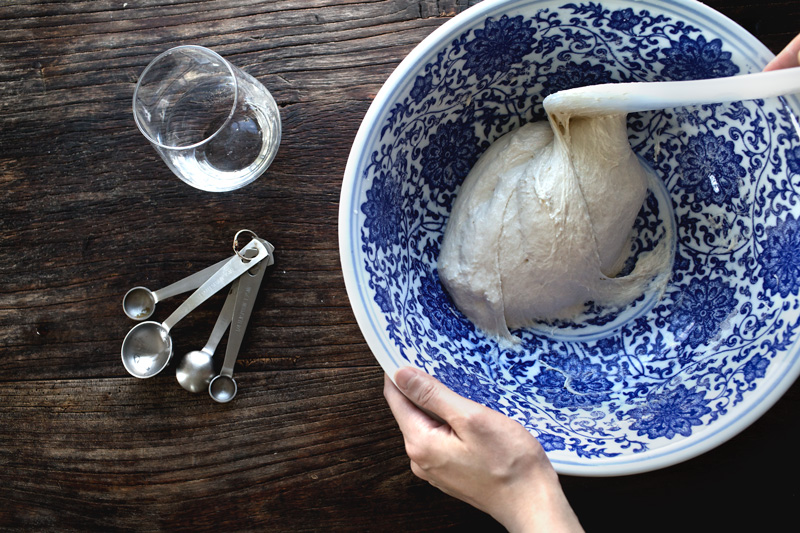
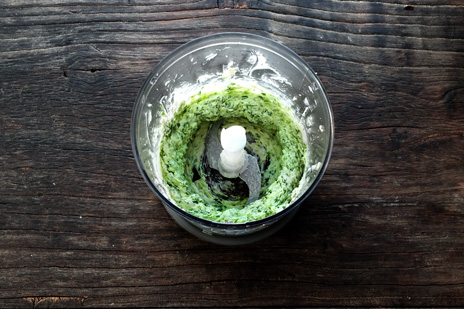
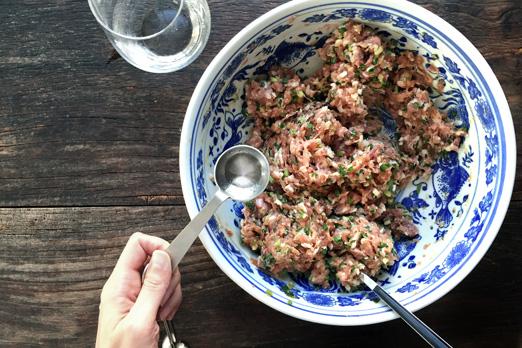
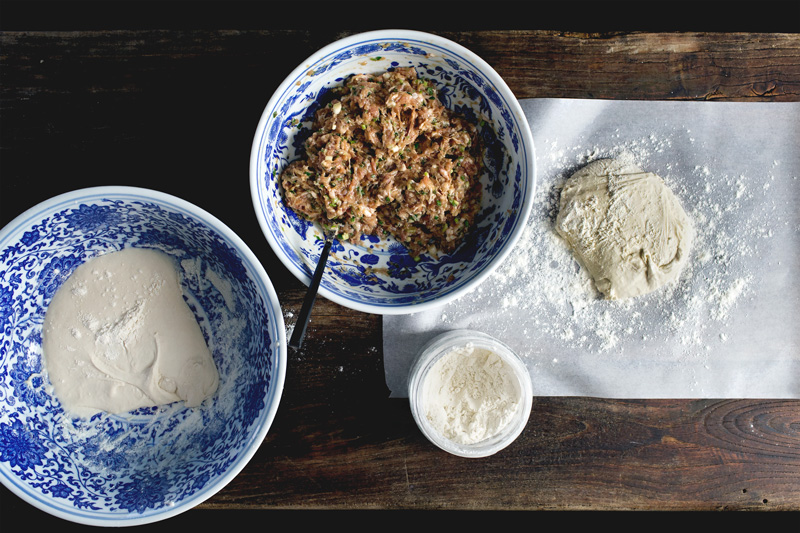



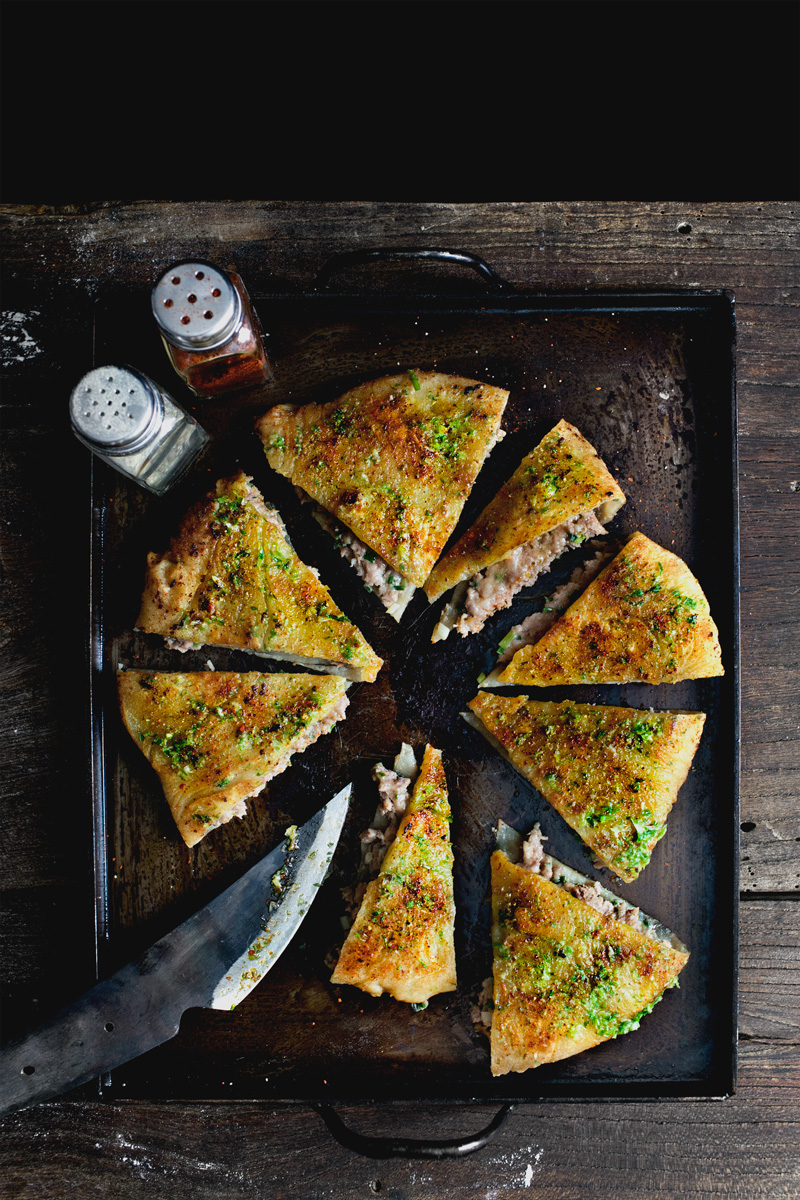

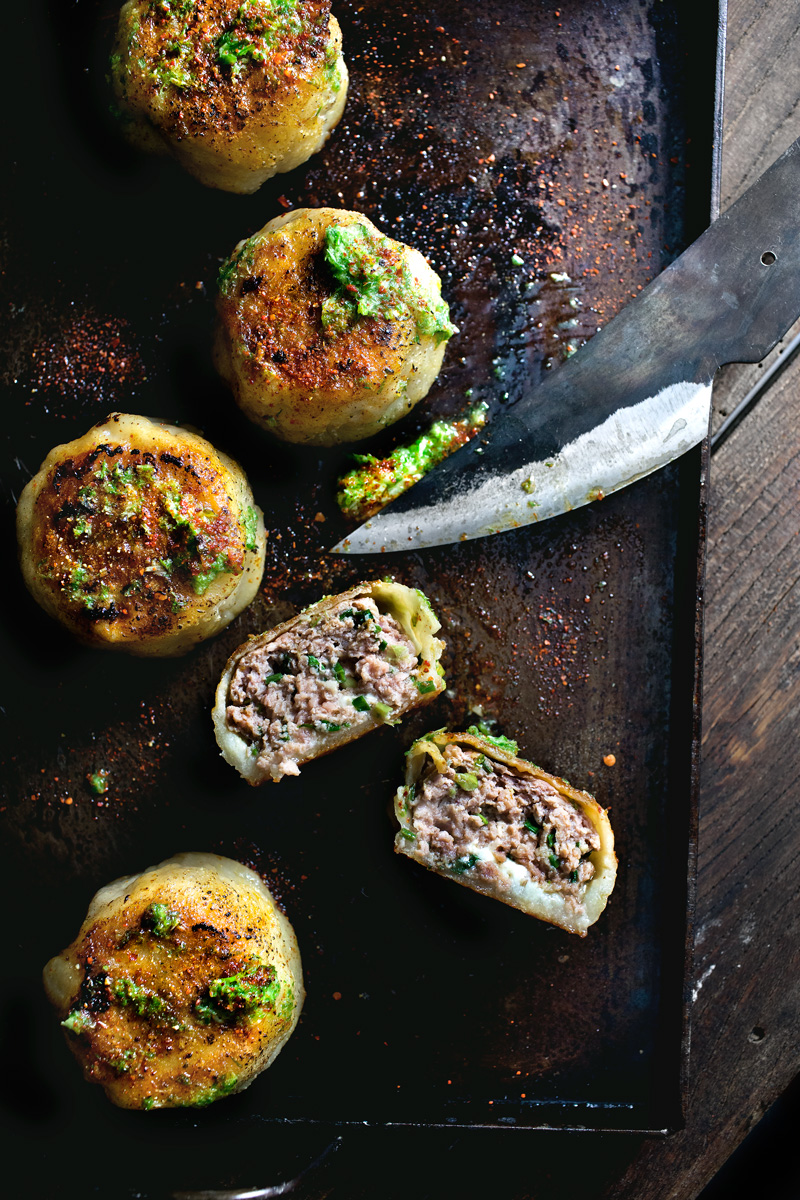
Anna
06.22.2015at10:57 PMHi Mandy,
As always I immensely enjoy your writing-style and story-telling :)
One question, does the dough rest at room temp or in fridge?
Sydney | Modern Granola
06.22.2015at11:08 PMI’ve never heard of door-nail meat pies before, but they look heavenly! I appreciate your reassuring words about cooking Chinese cuisine. And your photography is perfection. Thanks for sharing your knowledge and creativity!
xx Sydney
anita
06.23.2015at12:02 AMThat first picture could define food porn – god, it’s gorgeous. And I’ve never heard of these, but now I’m going to have to go try to make those door-nail pies!
Betty
06.23.2015at1:51 AMOh my gosh Mandy this post!!
1) I love the story – it’s always fascinating to hear about the legends surrounding certain foods.
2) Your presentation – I’m really loving the top-down shots (is this with your new tripod? If so it’s certainly working)
3) The layout – presenting the processes side by sides perfectly shows the differences and similarities. Now, knowing you were in architecture I feel like I can more appreciate the deliberateness in which you lay out your blog posts.
<3 This kind of reminds me of pork mooncake (suzhou style), but the dough is completely different. The filling is remarkably similar, but you know, pork and scallion – classic combination. I'm really intrigued by the scallion butter. Sounds so good and I bet it makes the dough super crisp.
mandy@ladyandpups
06.23.2015at12:51 PMBetty, haha thanks! Yeah I used my new tripod, which was trickier than I had wished, but i guess it does the trick… more or less. I love suzhou style moon cake! but never had fresh pork filling with it before (it was always ham or sweets). I’ve been wanting to make a su-style ham mooncake but… feeling lazy about it.
J.S. @ Sun Diego Eats
06.23.2015at2:11 AMI think Chinese food can be intimidating too because you don’t often see recipes for it. If you watch Food Network for 12 hours there will probably be at least 14 mac and cheese recipes or whatever but 0 this is how you make dumpling dough recipes. So at least here I think people don’t think of Chinese food as something you make at home but rather something you go out to order at a restaurant.
You just need to secure your own show and become the Chinese Ina Garten and soon everyone will confidently approach making meat pies like they do Ina’s 10 millionth roast chicken recipe (for Jeffrey’s birthday always)…
mandy@ladyandpups
06.23.2015at12:52 PMJS, we wouldn’t want adorable Jeffrey to starve now would we? i think Korea has done such a superb job at exporting their food culture in the past decade. i hope chinese food is next.
J.S. @ Sun Diego Eats
06.24.2015at1:03 AMI hope so. I’m half Chinese but haven’t had too much exposure to Chinese food having grown up in Brazil. But going to Shanghai for the first time in November to meet that side of the fam. I’ll be exporting a lot of food culture into my stomach :)
Ok that doesn’t even make sense but you know what I mean.
tunie
06.24.2015at1:06 AMyaasss…! Become the ” chinese ena garten” !! Ok, fine, stay covert so ‘adorable jeffrey’ can eat. But, please for the love of God, blog on!
Tanya Balyanitsa
06.23.2015at3:52 AMGosh! Looks like I need to make them for my husband :)) Thanks for recipe! Noted it!x
Ms. Mary M. Motta
06.23.2015at5:02 AMlove the narration! I so want to give this recipe a shot as well. thanks for posting it :]
kimithy
06.23.2015at5:19 AMI feel it necessary to mention that these so closely resemble scallops that I was so convinced that despite the description/title, this was a recipe for scallops, up until the end of the photos. And then you mentioned scallion butter, and I got scallions and scallops mixed up, and was SUPER impressed that you not only made scallop butter but that the meat pies also looked like scallops.
Scallion butter also sounds awesome, but now I’m curious about scallop-ginger butter…
Fin.
Jessica
06.23.2015at6:57 AMthe creativity of chinese dish and food naming is boundless. i guess people-naming, too, come to think of it… thank you for the gorgeous and scrumptious looking recipe!
Dulcistella
06.23.2015at5:37 PMQuestion, or, better, questions:
1) isn’t the dough going to be tough, as it is made with high gluten flour? Did you break it (the pie and/or the dough) while rolling the whole pie?
2) isn’t the filling going to be still a little bit raw, after only 5 + 5 min on the stove? Or is it thin enough?
Thanks!
then… “specification is the key to a believable bullshit” lol, I hope my colleague is not trying to understand why I’m laughing alone here in the lab… have a good day!
mandy@ladyandpups
06.23.2015at5:53 PMDulcistella, good questions!! 1) the warm/hot water is for this exact purpose, to soften the high gluten flour while retaining its elasticity. 2) it’s so hard to give an accurate timing because every stove is kind of different. Mine kind of did the trick for 5~6 min on each side (for the door-nail pie. the xianghe pie cooks faster), but you should judge it by your stove and experience :)
Tori@Gringalicious.com
06.23.2015at6:35 PMOMG, YUM! I have to have one of these asap!
Anne
06.24.2015at1:00 AMThat region thing is soo true! I spent half of my childhood in China and my parents always cook Chinese food, but I’ve never had meat pie before I came here! A (Chinese) friend invited me over for dinner and in her region, they eat meat pies! I was so surprised…
This looks amazing Mandy!!! I love how you spread scallion butter all over them!
Katalina @ Peas and Peonies
06.25.2015at1:25 AMOh wow these are beautiful, I wish I would as handy as you, my husband would be very happy if I would feed him something like that! Amazing as always!
Andrew | Kitchenthology
06.26.2015at4:34 AMAs a an immigrant baby now living in a completely white city, I can’t appreciate this post enough. Quick question though – do you think there’d be a noticeable difference in making this dough via a food processor over a stand mixer?
mandy@ladyandpups
06.26.2015at12:36 PMAndrew, I’ve never tried mixing a dough with food-processor so I can’t say. I’ve tried both stand-mixer and hand-held mixer (both with dough hooks), and the only difference is that stand-mixer gets the job done faster.
Liezl
06.29.2015at5:47 PMOh my word, this looks like cong you bing meets xiaolong bao! I am so trying these!! Xiaolong bao was my favourite thing ever to eat in Shanghai and came only second to cong you bing. Thanks for sharing! Love your writing style.
Kevin | keviniscooking
07.03.2015at12:08 AMThese simply look outstanding and I love little packets of goodness, all browned and seasoned to perfection. I always enjoy popping by your site and your writing is wonderful. Thanks! BTW these photos are simply beautiful.
Meg
07.05.2015at11:05 AMI saw this recipe on tumblr earlier today and skipped right past it thinking “Bah, I don’t like meat pies”. I saw it again this evening and thought “Well, it hardly looks like chicken pot pie. I might as well read it” So I click on over and see all the text, and I have to admit when I click over for a recipe I sometimes get annoyed at having the sift through three pages of musings about whatever the blogger was doing that day so I was a little iffy about reading your whole post.
I gotta say, you proved me wrong twice today. Very very wrong. Your writing is just delightful, I love hearing about the legends and how ridiculous they can get when you really think about it and how that has an effect of the mysticism relating to fairly simple food. PLUS these meat pies look and sound absolutely delicious, I will be trying them out sometime next week.
Now I’m off to explore the rest of your site :)
Esther
08.14.2015at10:23 AMThis looks famazing! I can’t wait to try it. Question for you. Do you see jian bing on the streets of Beijing? Those huge pancakes with green onions, sausages, and sometimes an egg folded into it? I dream of those and have tried recreating. But the jian bings I turn out are missing something. I’d love your thoughts on how to make jian bing at home.
mandy@ladyandpups
08.14.2015at1:32 PMEsther, I have a jianbing recipe on the blog! Search “jian bing” and you should find it :). As of this recipe, if you ever try it, just remember that the dough is quite wet and require a bit of handling. Good luck!
Chris
08.29.2015at3:16 PMI made these tonight, and despite not including the extra liquid, the juices were still runny from the meat. Maybe a little starch would help absorb and retain the meat juices in the pie rather than sogging up the beautifully crisped bottoms. Also, I think you should include a safety warning about laying the large into the pan and flipping them. Despite being my neurotic personality, i carelessly splashed a half pound meat pie into the pan and wound up getting oil on my shirt. but great flavors nonetheless!
mandy@ladyandpups
08.29.2015at6:22 PMChris, good to know! thanks for the tips!
Shannon
10.29.2015at1:35 AMI so enjoy your writing, and humor, and reference to jaded meat pies. I’m lusting after these and hope to make them soon!
Thanks for making this recipe so approachable.
Bob & Shan
11.06.2015at12:56 PMWe made these and they were absolutely amazing. We may never eat anything else again.
Alyson
01.05.2016at5:12 AMHi, I saw your recipe and would love to try it. Is there a way to make it gluten free?
mandy@ladyandpups
01.05.2016at12:35 PMAlyson, I’m afraid not.. :( Sorry!
Annie
10.17.2017at9:23 PMI had trouble with the dough when I made these. When I tried to wrap my first dumpling the dough tore quickly and was difficult to work with. I had to use a hand mixer and I’m guessing my problem is that I should have just mixed longer so the dough could get more elastic, but I’m wondering if you have any other tips for the dough. They are in the freezer waiting on a dim sum party so I can’t vouch for the final product, but I can’t wait to try them.
mandy@ladyandpups
10.18.2017at12:37 AMAnnie, was the dough too wet to work with? You can try dusting it very liberally with flour to give it more structure. Or it could be that it wasn’t rested long enough. I really hope it turns out ok:)
Constantine
02.13.2018at12:08 PMBesides the bullshit biographies (the more grass-root the food is, the more unconvincing the stories are), here is a fundamental difference between the two pies: a real-deal Mending should have Sichuan-pepper-infused-water as one of its major flavoring agent, while Xianghe is predominately scallion-flavored. It’s subtle, but I genuinely prefer the Sichuan pepper scented little meaty knobs.
Also, traditional Mending uses very fatty beef, making the entire thing exceedingly greasy but that’s part of the fun to eat it. That also makes the extra butter a little bit redundant (never tried making them with lean beef, but will indeed give it a shot some time!).